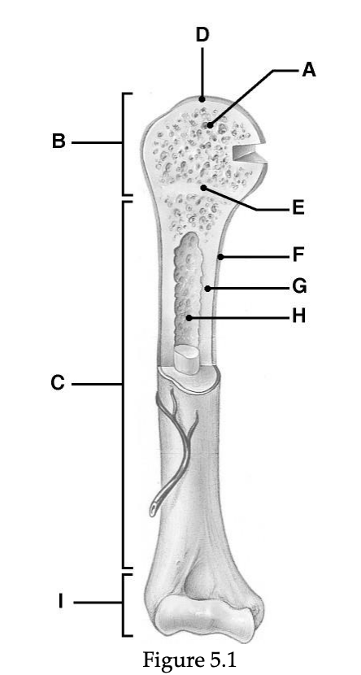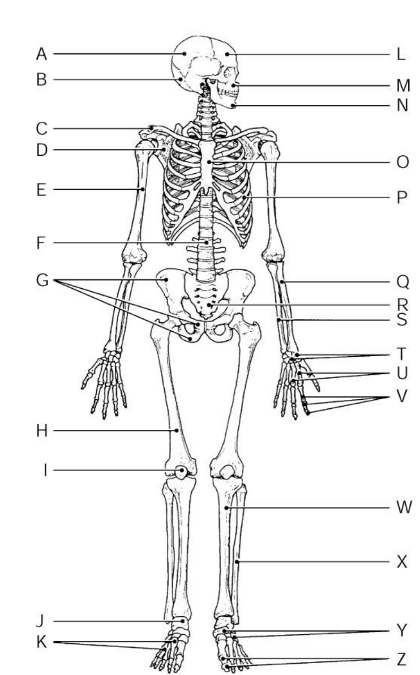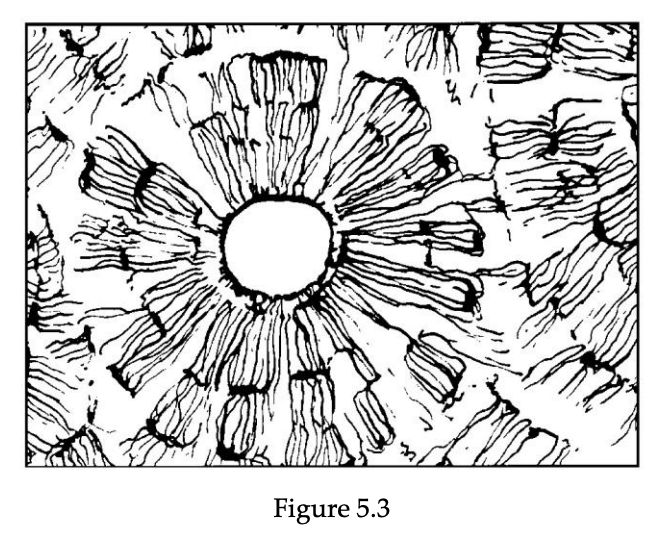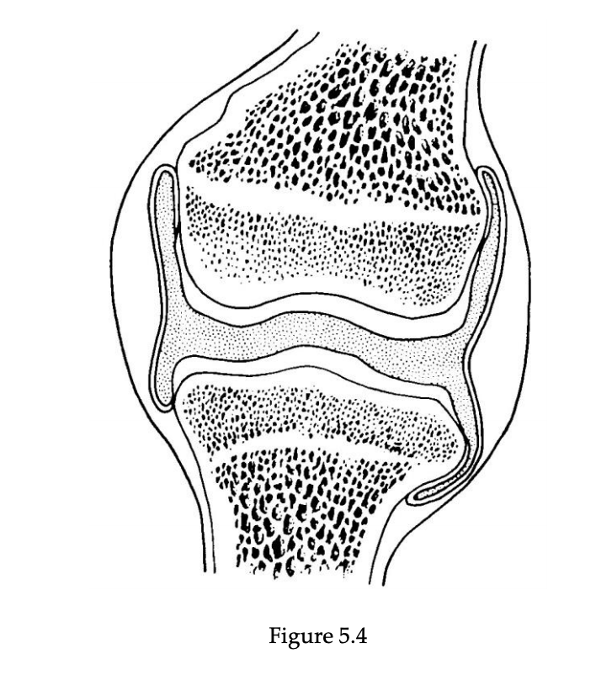
Spongy bone is indicated by letter __________.
A

The area that causes the lengthwise growth of a long bone is indicated by letter __________.
E

The area that serves as a storage area for fat in adults is indicated by letter __________.
H

The diaphysis is indicated by letter __________.
C

The distal epiphysis is indicated by letter __________.
I

The area that contains glassy hyaline cartilage that provides a smooth slippery surface which decreases friction is indicated by letter __________.
D

The frontal bone is indicated by letter __________
L

The femur is indicated by letter __________.
H

The fibula is indicated by letter __________.
X

The sternum is indicated by letter __________.
O

The radius bone is indicated by letter __________.
Q

The mandible is indicated by letter __________.
N

The scapula is indicated by letter __________.
D

The phalanges of the foot are indicated by letter __________.
Z

The sacrum is indicated by letter __________.
R
The most important minerals stored in bones are: A) calcium and iron
B) sodium and phosphorus
C) sodium and potassium
D) calcium and phosphorus
E) calcium and potassium
D

The type of tissue shown in Figure 5.3 is found mostly in:
A) articular cartilage
B) yellow marrow
C) the diaphysis
D) the epiphysis
E) short bones
C
Which of the following groups of bones in the human body, categorized according to shape, is correct:
A) wrist and ankle bones - long bones
B) arm and leg bones - short bones
C) skull bones - flat bones
D) coxal bones - irregular bones
E) cranium - sesamoid bones
D
Which of the following bone categories is composed of two layers of compact bone sandwiching a layer of spongy bone between them:
A) compact bone
B) irregular bone
C) flat bone
D) long bone
E) sesamoid bone
C
The periosteum is secured to the underlying bone by dense connective tissue fibers called: A) Volkmann's canals
B) a bony matrix with hyaline cartilage
C) Sharpey's fibers
D) endochondral bone
E) articular cartilage
C
In adults, the function of the yellow marrow is to:
A) store adipose tissue
B) form blood cells
C) store calcium and phosphorus
D) cause lengthwise growth in long bones
E) decrease friction at joint surfaces
A
The presence of an epiphyseal plate indicates that:
A) bone is dead
B) bone length is no longer increasing
C) bone diameter is increasing
D) bone diameter is decreasing
E) bone length is increasing
E
Osteons are characteristic of __________.
A) articular cartilage
B) spongy bone
C) compact bone
D) yellow marrow
E) Sharpey's fibers
C
The bone cells within lacunae receive nourishment from blood vessels through passageways called:
A) Haversian canals
B) perforating canals
C) lamellae
D) medullary cavities
E) canaliculi
E
A shallow, basin-like depression in a bone often serving as an articular surface is a:
A) sinus
B) meatus
C) fossa
D) foramen
E) groove
C
A round or oval opening through a bone is a:
A) facet
B) fossa
C) foramen
D) fissure
E) trochanter
C
Which of these are bone-forming cells:
A) osteocytes
B) canaliculi
C) osteoclasts
D) osteoblasts
E) lamellae
D
The canal that runs through the core of each osteon contains:
A) cartilage and lamellae
B) osteoclasts and osteoblasts
C) yellow marrow and Sharpey's fibers
D) blood vessels and nerve fibers
E) red marrow
D
The small cavities in bone tissue where osteocytes are found are called:
A) lacunae
B) Volkmann's canals
C) Haversian canals
D) trabeculae
E) lamellae
A
What kind of tissue is the forerunner of long bones in the embryo:
A) elastic connective tissue
B) dense fibrous connective tissue
C) fibrocartilage
D) hyaline cartilage
E) loose fibrous connective tissue
D
Which of the following is an example of a bone that forms from fibrous membranes:
A) the parietal bone
B) the radius
C) the humerus
D) the femur
E) the tibia
A
The factor(s) that determine where bone matrix is to be remodeled is (are):
A) sex hormones
B) growth hormone
C) stresses of gravity and muscle pull on the skeleton
D) parathyroid hormone (PTH)
E) calcium level of the blood
C
There are four stages in the healing of a bone fracture. Which of the following best illustrates the sequence of these stages:
1. bony callus formation
3. fibrocartilage callus formation
2. bone remodeling
4. hematoma formation
A) 4, 3, 2, 1
B) 4, 3, 1, 2 C) 1, 2, 3, 4
D) 1, 3, 4, 2
E) 1, 3, 2, 4
B
What type of cell does parathyroid hormone (PTH) activate:
A) osteocyte
B) osteoblast
C) osteoclast
D) periosteum
E) lacunae
C
A compound fracture can be described as when:
A) the bone is crushed
B) the broken bone ends are forced into each other
C) the broken bone is exposed to the outside
D) the bone is broken into many fragments
E) adjacent bones fracture simultaneously
C
A bone fracture where the bone is broken into many fragments is a:
A) compound fracture
B) simple fracture
C) comminuted fracture
D) compression fracture
E) greenstick fracture
C
A fracture that is common in children, whose bones have relatively more collagen in their matrix and are more flexible than those of adults, is a(n):
A) impacted fracture
B) spiral fracture
C) depressed fracture
D) greenstick fracture
E) open fracture
D
A fracture that is common in osteoporotic bones is a(n):
A) impacted fracture
B) compression fracture
C) spiral fracture
D) depressed fracture
E) simple fracture
B
The axial skeleton contains:
1. skull
2. arms and legs
3. ribs and sternum
4. vertebrae
5. pelvic girdles
A) 1, 3, 4, 5
B) 1, 3, 4
C) 2, 5
D) 2, 3, 4, 5
E) 1, 2, 3, 5
B
The suture found between the parietal and temporal bone is the:
A) squamous suture
B) lambdoid suture
C) sagittal suture
D) coronal suture
E) both the squamous suture and the sagittal suture
A
All of the following facial bones are paired except one. Which of the following is the unpaired facial bone:
A) palatine
B) lacrimal
C) vomer
D) maxillae
E) zygomatic
C
The middle nasal conchae are part of the:
A) maxillae
B) sphenoid bone
C) nasal bone
D) vomer bone
E) ethmoid bone
E
Which of these bones is NOT associated with the foot:
A) talus
B) calcaneus
C) metatarsals
D) tarsals
E) metacarpals
E
The hyoid bone is unique because:
A) it is the only bone of the body that does not directly articulate with any other bone
B) it has an unusual shape
C) it is covered with mucosa
D) it has no specific function
E) it largely consists of cartilage
A
The sella turcica is part of the __________ bone. A) parietal
B) ethmoid
C) sphenoid
D) temporal
E) frontal
C
There are __________ vertebrae in the neck region.
A) five thoracic
B) seven lumbar
C) seven cervical
D) twelve thoracic
E) five lumbar
C
Transverse foramina are found in the:
A) sacrum
B) coccyx
C) thoracic vertebrae
D) lumbar vertebrae
E) cervical vertebrae
E
The atlas is the:
A) last lumbar vertebra
B) first thoracic vertebra
C) part of the sacrum
D) second cervical vertebra
E) first cervical vertebra
E
Which is the correct order of ribs, from superior to inferior:
A) floating ribs, true ribs, false ribs
B) floating ribs, false ribs, true ribs
C) true ribs, false ribs, floating ribs
D) true ribs, floating ribs, false ribs
E) false ribs, floating ribs, true ribs
C
The sternum is the result of fusion of three bones called the:
A) ischium, ilium, coccyx
B) pubis, ischium, ilium
C) manubrium, body, xiphoid process
D) jugular notch, sternal angle, xiphisternal joint
E) true ribs, manubrium, xiphoid process
C
The greater trochanter is located on the:
A) radius
B) humerus
C) fibula
D) tibia
E) femur
E
The tailbone is the:
A) ischium
B) sacrum
C) pubis
D) coccyx
E) patella
D
Which of the following is correct of the female pelvis when comparing it with the male pelvis: A) the angle of the female pubic arch is smaller B) the distance between the female ischial spines is greater
C) the distance between the female ischial tuberosities is less
D) the female iliac bones are less flared
E) the female pelvis as a whole is deeper, and the bones are heavier and thicker
B

The type of joint shown in Figure 5.4 is:
A) a suture
B) a fibrous joint
C) an amphiarthrotic joint
D) a cartilaginous joint
E) a synovial joint
E
A structure found on the femur is the:
A) anterior crest
B) trochlea
C) lateral malleolus
D) intercondylar fossa
E) medial malleolus
D
Articulations permitting only slight degrees of movement are __________, whereas articulations permitting no movement are called __________.
A) amphiarthroses; synarthroses
B) synarthroses; amphiarthroses
C) diarthroses; amphiarthroses
D) amphiarthroses; diarthroses
E) diarthroses; synarthroses
A
Fingers and toes are referred to as:
A) tarsals
B) metacarpals
C) phalanges
D) metatarsals
E) carpals
C
Which of these bones is NOT a long bone found in the leg:
A) femur
B) patella
C) fibula
D) metatarsals
E) tibia
B
Four of the five answers listed below are parts of the same anatomical area. Select the exception.
A) humerus
B) radius
C) scapula
D) fibula
E) clavicle
D
Bone formation can be referred to as:
A) osteoporosis
B) rickets
C) ossification
D) gout
E) osteoarthritis
C
Hematopoiesis refers to the formation of blood cells within the red marrow cavities of certain bones. (T/F)
True
The diaphysis of a long bone is composed of spongy bone. (T/F)
False
All flat bones are formed from hyaline cartilage. (T/F)
False
Osteoblasts respond to the parathyroid hormone (PTH). (T/F)
False
The master gland of the body (pituitary gland) is housed in a saddlelike depression in the temporal bone called the sella turcica. (T/F)
False
Ribs numbered 11 and 12 are true ribs because they have no anterior attachments. (T/F)
False
The zygomatic bones form the cheekbones. (T/F)
True
The spinal cord passes through the body of each vertebra. (T/F)
False
Most of the stress on the vertebral column occurs on the sturdiest vertebrae in the sacral region. (T/F)
False
In anatomical position, the lateral lower leg bone is the fibula. (T/F)
True
There are seven cervical, twelve thoracic, and five lumbar vertebrae. (T/F)
True
Spinal curvatures that are present at birth are called primary curvatures (the cervical and lumbar curvatures) and those that develop later are secondary curvatures (the thoracic and sacral curvatures). (T/F)
False
The heaviest, strongest bone in the body is the femur. (T/F)
True
Fontanels allow for growth of the brain. (T/F)
True
An incomplete fracture or cracking of the bone without actual separation of the parts
A) comminuted
B) compression
C) greenstick
D) depressed
E) impacted
C
Fracture where bone fragments into many pieces
A) comminuted
B) compression
C) greenstick
D) depressed
E) impacted
A
Fracture in which broken bone ends are forced into each other
A) comminuted
B) compression
C) greenstick
D) depressed
E) impacted
E
Type of fracture in which bone is crushed
A) comminuted
B) compression
C) greenstick
D) depressed
E) impacted
B
Type of fracture in which the broken bone portion is pressed inward
A) comminuted
B) compression
C) greenstick
D) depressed
E) impacted
D
Cells that can dissolve the bony matrix
A) epiphyseal plate
B) canaliculi
C) Sharpey's fibers
D) osteoblasts
E) osteons
F) epiphyseal line
G) lacunae
H) lamellae
I) osteocytes
J) osteoclasts
J
Layers of calcification that are found in bone
A) epiphyseal plate
B) canaliculi
C) Sharpey's fibers
D) osteoblasts
E) osteons
F) epiphyseal line
G) lacunae
H) lamellae
I) osteocytes
J) osteoclasts
H
Small channels that radiate through the matrix of bone
A) epiphyseal plate
B) canaliculi
C) Sharpey's fibers
D) osteoblasts
E) osteons
F) epiphyseal line
G) lacunae
H) lamellae
I) osteocytes
J) osteoclasts
B
Cells that can build bony matrix
A) epiphyseal plate
B) canaliculi
C) Sharpey's fibers
D) osteoblasts
E) osteons
F) epiphyseal line
G) lacunae
H) lamellae
I) osteocytes
J) osteoclasts
D
Area where bone growth takes place
A) epiphyseal plate
B) canaliculi
C) Sharpey's fibers
D) osteoblasts
E) osteons
F) epiphyseal line
G) lacunae
H) lamellae
I) osteocytes
J) osteoclasts
A
Wrist Joint
A) hinge joint
B) ball-and-socket joint
C) plane joint
D) pivot joint
E) saddle joint
F) condyloid jont
C
Shoulder joint
A) hinge joint
B) ball-and-socket joint
C) plane joint
D) pivot joint
E) saddle joint
F) condyloid jont
B
Elbow joint
A) hinge joint
B) ball-and-socket joint
C) plane joint
D) pivot joint
E) saddle joint
F) condyloid jont
A
Knuckle joints
A) hinge joint
B) ball-and-socket joint
C) plane joint
D) pivot joint
E) saddle joint
F) condyloid jont
F
Joint between atlas and axis
A) hinge joint
B) ball-and-socket joint
C) plane joint
D) pivot joint
E) saddle joint
F) condyloid jont
F
Patella
A) irregular bone
B) flat bone
C) short and sesamoid bone
D) short bone
E) long bone
C
Femur
A) irregular bone
B) flat bone
C) short and sesamoid bone
D) short bone
E) long bone
E
Carpals
A) irregular bone
B) flat bone
C) short and sesamoid bone
D) short bone
E) long bone
D
Ulna
A) irregular bone
B) flat bone
C) short and sesamoid bone
D) short bone
E) long bone
E
Atlas
A) irregular bone
B) flat bone
C) short and sesamoid bone
D) short bone
E) long bone
A
Sternum
A) irregular bone
B) flat bone
C) short and sesamoid bone
D) short bone
E) long bone
B
Fibula
A) irregular bone
B) flat bone
C) short and sesamoid bone
D) short bone
E) long bone
E
Coxal Bone
A) irregular bone
B) flat bone
C) short and sesamoid bone
D) short bone
E) long bone
A
True ribs
A) irregular bone
B) flat bone
C) short and sesamoid bone
D) short bone
E) long bone
B
Parietal bones
A) irregular bone
B) flat bone
C) short and sesamoid bone
D) short bone
E) long bone
B